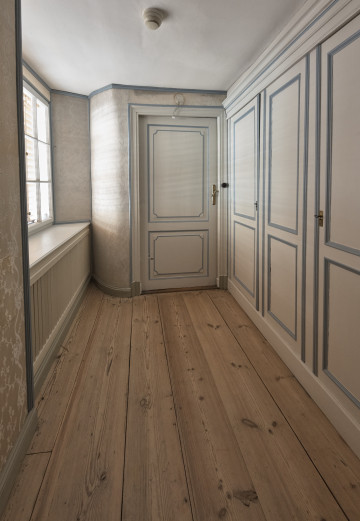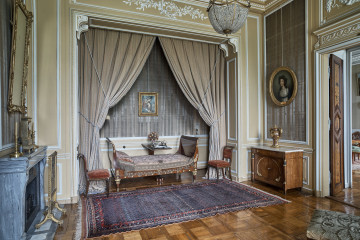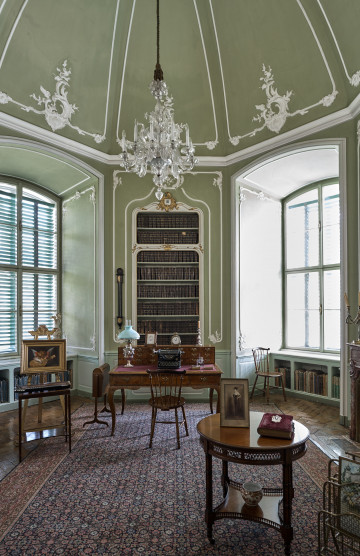
Chinese Suite, Walk-in closet - access to the bathroom
Castle Museum in Łańcut
Part of the collection: Interiors
Historical names: “Chambre de Parade” (ca. 1780); “Apartment of the Duke General”, (after 1783 – early 19th c.); “HE IM Duke’s Bedroom” (until 1862); “His Excellency’s Bedroom” (from 1862); “bedroom” (until 1889); “the gala apartment” (1890s); “the Parade Room” (1933)
Other names: The Parade Lounge, the Parade Suite Salon
Time of construction: 1629-1642 (?); ca. 1780 – “Chambre de Parade”; after 1780-19th c. – change of decor and function; 1890s – change of decor and function
Architects: N.N. (1629-1890s); Amand Louis Bauqué, Albert Pio (1890-1895, change of decor)
Artists: Franciszek Smuglewicz (door polychromy, 1790s); Viennese carpenters (1890s)
Description:
The Parade Salon is one of the three rooms of the Parade Suite located in the eastern enfilade of the castle’s first floor. Around 1780 there was an apartment similar to the Women’s Suite (Izabela Lubomirska’s) in the northern wing.
The eastern living room “Chambre de Parade”, located between the hall and the bedroom, had two doors in the enfilade, was lit by two windows in the eastern wall and heated by a fireplace and a stove in the northern wall.
Known as the “Apartment of the Duke General”, the room served as the bedroom of Adam Kazimierz Czartoryski (+1823), the brother of the Duchess Marshal, who would visit Łańcut. In the early 19th century, the room had “Parisian paper upholstery, with white baskets painted on ribbons hanging at the bottom.”
After the death of Izabela Lubomirska in 1816 and the division of property among her grandsons in 1822, Alfred I Potocki became the owner of Łańcut (he married Józefina Czartoryska in 1814).
The young Potocki family arranged their apartment in the rooms on the first floor of the eastern wing of the castle, called the Winter Apartment. It also included the former “Duke General’s Apartment”, which was arranged as “HE IM Duke’s Bedroom”.
In Alfred I Potocki’s bedroom, the ceiling was painted, the walls “in wallpaper”, and the floor was laid “in pine sheets”. The room was heated by a “square, bricked” stove and a “case fireplace with granite stone cladding”. In the passages of the enfilades in the mid-19th century, the door was “veneered with mahogany, double [...] decorated with a painting, under varnish”. The third small door “hidden in the wall” led to the “passage”.
After Józefina and Alfred I Potocki died in 1862, the Łańcut castle was inherited by their son and successor of the ordinance, Alfred II Potocki, who married Maria Sanguszkówna in 1851. They arranged their apartments on the first floor. Alfred II took the Men’s Suite (formerly the northern one of Stanisław Lubomirski), and his wife moved to the east wing, taking up part of the Winter Apartment. The former “Chambre de Parade”, later used as the bedroom of Adam Kazimierz Czartoryski, and then Alfred I Potocki, became Maria Potocka’s bedroom. Her daughter-in-law, Elżbieta née Radziwiłł, wife of Roman Potocki, remembered the interior as follows: “From the other side of the dining room, one enters my mother-in-law’s apartment. A bedroom with a large floral pattern wallpaper [...], a bathroom next door [...]. The washroom was located in a small adjoining room [...].”
After the death of Alfred II in 1889, during the reconstruction of the castle carried out for Elżbieta and Roman Potocki in 1889-1912 according to the designs of Amand Louis Bauqué and Albert Pio, the Bedroom of Maria née Sanguszko was incorporated into the Parade Suite intended for the most distinguished guests visiting Łańcut. Elżbieta Potocka wrote in her diaries: “[...] carpenters made panelling [...] in the gala apartment, formerly my mother-in-law”.
The Potockis kept two pairs of classicist, mahogany, polychrome doors located in the passages of the eastern enfilade. In the panels, apart from the grotesque paintings, in the central hexagonal fields, there are images of Minerva and Apollo (northern door) and two vases (southern door). The author of the paintings from the 1790s was likely Franciszek Smuglewicz.
In the newly decorated neoclassical Lounge of the Parade Suite, the walls were lined with light grey panelling, in the lower part – paneled, in the upper – a frame loom, filled with a fabric with an alternating striped pattern. Narrow panels separating the individual loom fields were decorated with carvings. Campanula overhangs and an ornamental frieze in a lintel topped with a cornice were used in the rich framing of the door portals. The stuccoes of the interior consist of decorations in overdoors with a motif of women’s heads in medallions supported by putti and a crowning cornice embellished with cymatium, palmettes and dicing. The ceiling, distinguished with the profiling from the facettes, is decorated with a stucco rosette in the middle and lyre motifs in the corners. On the southern axis of the wall, there is a white marble fireplace with the figure of a lying woman in a cartouche on the frieze. At the top of the mirror above the fireplace, a medallion with a bas-relief of Cupid surrounded by floral overhangs. A circular classicising stove was placed in the northwest corner. A neoclassical crystal chandelier and a wooden floor arranged in a rhomboid star pattern complement the decor.
Basic bibliography:
• Kossakowska-Szanajca Zofia, Majewska-Maszkowska Bożenna, Zamek w Łańcucie, Warsaw 1964
• Majewska-Maszkowska Bożenna, Mecenat artystyczny Izabelli z Czartoryskich Lubomirskiej, Warsaw 1976
• Omilanowska Małgorzata, Jakub Sito, Łańcut i okolice [in:] Katalog Zabytków Sztuki w Polsce, Institute of Art of the Polish Academy of Sciences, Warsaw 1994
• Potocka Elżbieta, Łańcut – memoirs from 1885 to 1915 [Diary, typescript in the collection of the Castle Museum in Łańcut]
• Piotrowski Józef, Zamek w Łańcucie, Lviv 1933
Elaboration:
Teresa Bagińska-Żurawska https://orcid.org/0000-0002-9243-3967
Faustyna Bożętka
Object type
Interiors
Creation / finding place
Owner
Castle Museum in Łańcut
Identification number
Location / status

Castle Museum in Łańcut

Castle Museum in Łańcut

Castle Museum in Łańcut
DISCOVER this TOPIC
National Museum in Szczecin
DISCOVER this PATH
Educational path